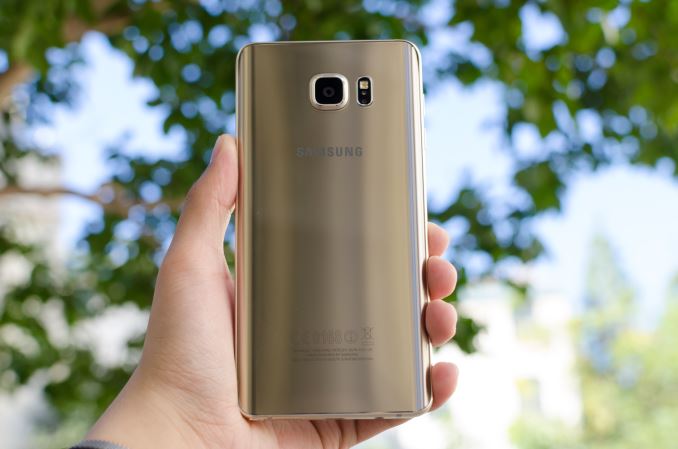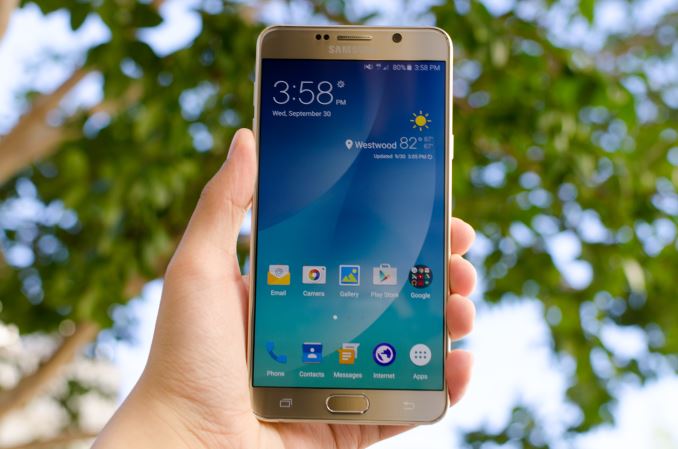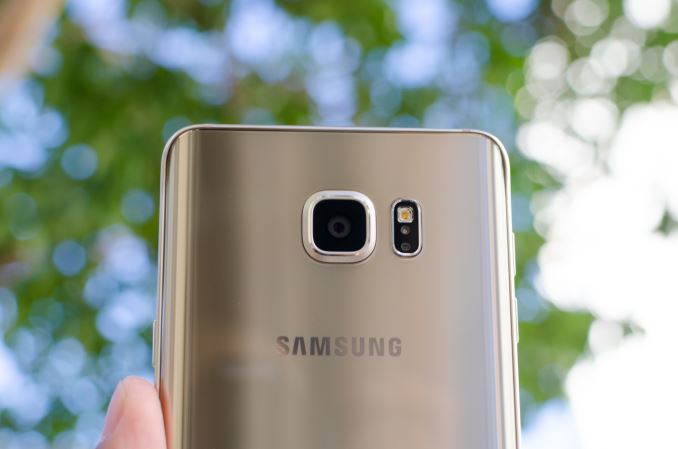The Samsung Galaxy Note5 and Galaxy S6 edge+ Review
by Joshua Ho on October 2, 2015 8:00 AM ESTFinal Words
The Galaxy Note5 is a bit of a break in form for Samsung, but in some ways it represents a return to form. To understand what this means, we can look at the various aspects that make up the Galaxy Note5 in contrast to the Galaxy S6. One of the easier places to start is the design, which shares a great deal in common with the Galaxy S6. We see a similar reflective coating under the glass, a glass back cover, an aluminum midframe, and the usual home button and thin bezels. The fingerprint scanner in the home button works about as well as you would expect and is comparable to the Galaxy S6.
The next aspect of the phone worth looking at is battery life. Here, we see that the Note5 gets a healthy bump in battery life relative to the Galaxy S6. Relative to the Note 4, battery life is basically comparable and not all that different. It seems that Samsung’s theme this year is maintaining battery life by reducing battery size and improving power efficiency. Those looking for a removable battery might be disappointed, but if you never swapped the battery in a phone like the Galaxy Note 4 there’s nothing to really worry about here. Samsung has also retained fast charging capabilities, so it isn’t nearly as important to swap batteries.
The display of the Galaxy Note5 continues to be incredible. Out of all the Android OEMs right now, Samsung is the best at display. I’m still of the opinion that the best LCDs are comparable with Samsung’s latest AMOLED panels, but within the next year or two I’m fairly confident that they won’t have any competition here. However, given the lack of second source suppliers it seems unlikely that OEMs will move en masse to OLED as strongly relying on a single supplier for any critical part of a product could easily be a disastrous mistake. The Galaxy S6 edge+ has a similar level of display quality, but the edges of the display are clearly distorted to the eye due to the subpixel arrangement used.
The SoC used continues to be the best SoC you can get in any mobile device running Android. This is likely to change next year, but given the data it’s incontrovertible that the Exynos 7420 is the fastest and most efficient SoC available in an Android device. These two factors strongly affect user experience in workloads like web browsing, updating and installing apps, and gaming. If you do any of those three things, SoC performance has a strong influence upon overall user experience for you. NAND quality isn’t quite at the same level as the Galaxy S6, but it’s more than sufficient and is unlikely to be a problem for the duration of a two year contract.
Overall, the software experience is actually quite acceptable. TouchWiz has gotten a lot better in the past generation, and any time I pick up a Galaxy S3 or Galaxy S4 I’m immediately reminded of this. However, as mentioned in the Galaxy S6 review I don’t think it’s necessarily perfect. The smoothness of the UI isn’t as amazing as some of the phones I’ve used in the past, and there are sometimes odd choices in application design like icon design. Using a Material Design theme from the theme store goes a long way to dealing with this problem, but that’s no excuse for the default theme. The Note features are useful and the single biggest reason to buy the Galaxy Note5 over another phablet, but the edge features are decidedly impractical and generally not very useful. I still think it's possible to make a better skin than TouchWiz, but I can live with TouchWiz on a primary phone.
In the camera department, on the surface nothing has changed relative to the Galaxy S6. Even if Samsung didn’t do anything for the Galaxy Note5’s camera relative to the Galaxy S6, it would still be one of the best Android cameras you can get today. However, Samsung has included a number of new features like RAW capture and improved manual mode controls. In addition, they’ve dramatically improved low light photo processing to the point that I’m confident in saying that the Galaxy Note5 beats the LG G4 and iPhone 6 Plus, but in video performance the iPhone 6 Plus is still slightly better. The Galaxy Note5 is either as good as or better than the iPhone 6 Plus for overall camera quality depending upon how strongly you want to weight video recording.
Outside of these main areas of focus, overall I like the the Galaxy Note5. In chosing to mimic the Galaxy S6 so closely it's not a bold design for Samsung and you won't find much in the way of new features, but instead what you get is in many ways a big Galaxy S6. Often because of that it's not a perfect phone - Samsung could still afford to work on polish, particularly in regards to issues like inserting the stylus backwards or RAW files that aren’t deleted - however it also does a lot well like the 5.7" SAMOLED display, the camera, and the Exynos 7420 SoC.
If you’re looking for the best Android phablet on the market today the Galaxy Note5 or Galaxy S6 edge+ is likely to be your best bet. They may not be a big jump up from the Galaxy S6, but they're still the best Android phablets you can get today. In that sense, Samsung is departing from the sort of strategy that we saw with the Galaxy Note 3 and 4 in the form of a new SoC and other improvements that came with the Note line, but like the Galaxy Note 1 and 2 these are phablet variants of their Galaxy S cousin.















225 Comments
View All Comments
kspirit - Friday, October 2, 2015 - link
Display and battery numbers, etc are on par with the iPhone 6 which is a year old now. The 6S looks like it'll wreck this thing.RMSe17 - Friday, October 2, 2015 - link
Except for the GFX battery, judging by how quickly the 6 ran out.kaidenshi - Sunday, October 4, 2015 - link
Maybe I just don't use my phone enough, but typically at the end of the day I still have around 40-50% battery life on my iPhone 6. My previous device was a Moto G, which was supposedly great with battery life but it would die on me around dinner time even on a light use day.Of course, I'm actually getting work done during the day instead of screwing around on Facebook or Bejeweled clones for 8+ hours at work, so there's that.
LoganPowell - Friday, November 27, 2015 - link
Both phones are good. But between the two, the Galaxy S6 Edge is way better receiving a higher review (see http://www.consumerrunner.com/top-10-best-phones/ for instance...) than S5.farhadd - Monday, October 5, 2015 - link
The reason the iphone 6 runs down fast is because it doesn't throttle the frame rate. It doesn't have to throttle because the metal enclosure can dissipate the heat efficiently enough to keep up.Oyeve - Friday, October 2, 2015 - link
Isnt the display on the 6 and 6s basically the same?close - Friday, October 2, 2015 - link
iPhone 6s has basically the same battery lifetime in real life experience because the battery is a bit smaller. So I really think "wreck" is a way to strong word.tipoo - Friday, October 2, 2015 - link
The 6S has nearly identical display and battery properties (slightly worse) as the 6...?kspirit - Friday, October 2, 2015 - link
It has presumably has a very fast chipset and storage though. Let's see how the camera stacks up to this, as well. I love how they designed the Note 5 but I'm so hesitant to go back to Samsung software after reading all those threads about people running into issues, on reddit :(abrogan - Friday, October 2, 2015 - link
In my family, 2 S4's died quickly after being purchased. My brother has a perfect Note 4, but my neighbor's sister bought an S6. Even after a fresh reformat, it always has the "google play services has stopped responding" error. No way to fix as far as I can tell... it's useless for her, and all the money wasted... My Nexus never has any software bugs, so I'm sticking with Nexus myself. I've had 3 perfect Nexus phones, so I'll buy another Nexus. Not very scientific, but....